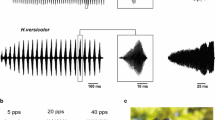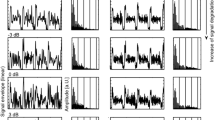Abstract
Male grasshoppers of the species Chorthippus biguttulus react to female songs with a characteristic turn towards the female. The probability of turning towards female song models was used to evaluate those parameters which are essential for a signal to be interpreted as female song.
-
1.
The shape of sound pulses turned out to be most decisive; pulses with ramps rising gradually over 3 and more ms were efficient (Figs. 2, 3), whereas rectangularly modulated pulses evoked only weak responses and only when pulse intervals were between 3 and 5 ms (Fig. 2). The decline of a pulse did not influence its efficiency (Fig. 3). In particular, pulses with sudden onsets and gradual declines were as weakly effective as rectangularly modulated ones and thus remarkably less effective than pulses with ramp-like onsets (Fig. 4).
-
2.
Intensity tuning curves suggest, that the absolute steepness of ramps (expressed as μbar/ms) is detected by the grasshopper nervous system (Figs. 6, 7), possibly by processing the delay in excitation onset of at least two receptor types differing in threshold sensitivity.
-
3.
The sawtooth shape of pulses in female signals is suggested to be adaptive with respect to directional hearing.
Similar content being viewed by others
References
Adam LJ (1977) The oscillating summed action potential of an insect's auditory nerve (Locusta migratoria, Acrididae) I. Its original form and time constancy. Biol Cybern 26:241–247
Busnel RG (1963) On certain aspects of animal acoustic signals. In: Busnel RG (ed) Acoustic behaviour of animals. Elsevier, Amsterdam London New York, 69–133
Busnel RG, Loher W (1961) Declenchement de phonoréponses chez Chorthippus brunneus (Acrididae). Acustica 11:65–70
Dumortier B (1963) Ethological and physiological study of sound emissions in Arthropoda. In: Busnel RG (ed) Acoustic behaviour of animals. Elsevier, Amsterdam London New York, 583–654
Elsner N (1974) Neuroethology of sound production in gomphocerine grasshoppers. I. Song patterns and stridulatory movements. J Comp Physiol 88:72–102
Elsner N, Popov AJ (1978) Neuroethology of acoustic communication. Adv Insect Physiol 13:229–355
Ewing AW (1989) Arthropod bioacoustics. Neurobiology and behaviour. Edinburgh Univ Press, Edinburgh, 167–174
Hall JC, Feng AS (1988) Influence of envelope rise time on neural responses in the auditory system of anurans. Hearing Res 36:261–276
Helversen D v (1972) Gesang des Männchens und Lautschema des Weibchens bei der Feldheuschrecke Chorthippus biguttulus (Orthoptera, Acrididae). J Comp Physiol 81:381–422
Helversen D v, Helversen O v (1983) Species recognition and acoustic localization in acridid grasshoppers: a behavioural approach. In: Huber F, Markl H (eds) Neuroethology and behavioural physiology. Springer, Berlin Heidelberg New York Tokyo, 95–107
Helversen D v, Rheinlaender J (1988) Interaural intensity and time discrimination in an unrestraint grasshopper: a tentative approach. J Comp Physiol A 162:333–340
Helversen O v, Helversen D v (1987) Innate receiver mechanisms in the acoustic communication of orthopteran insects. In: Guthrie V (ed) Aims and methods in neuroethology. Manchester Univ Press, Manchester, 104–150
Marquart V (1985) Local interneurons mediating excitation and inhibition onto ascending neurons in the auditory pathway of grasshoppers. Naturwissenschaften 72:42–44
Mörchen A, Rheinlaender J, Schwartzkopff J (1978) Latency shift in insect auditory nerve fibers. A neuronal time cue of sound direction. Naturwissenschaften 65:656–657
Rheinlaender J, Mörchen A (1979) “Time-intensity-trading” in locust auditory interneurones. Nature 281:672–674
Römer H (1976) Die Informationsverarbeitung tympanaler Rezeptorelemente von Locusta migratoria. J Comp Physiol 109:101–122
Römer H, Marquart V (1984) Morphology and physiology of auditory interneurons in the metathoracic ganglion of the locust. J Comp Physiol A 155:249–262
Römer H, Rheinlaender J, Dronse R (1981) Intracellular studies on auditory processing in the metathoracic ganglion of the locust. J Comp Physiol 144:305–312
Ronacher B, Römer H (1985) Spike synchronization of tympanic receptor fibers in a grasshopper (Chorthippus biguttulus L., Acrididae). J Comp Physiol A 157:631–642
Stumpner A, Ronacher B (1991) Auditory interneurones in the metathoracic ganglion of the grasshopper Chorthippus biguttulus. I. Morphological and physiological characterization. J Exp Biol 158:391–410
Stumpner A, Ronacher B, Helversen O v (1991) Auditory interneurones in the metathoracic ganglion of the grasshopper Chorthippus biguttulus. II. Processing of temporal patterns of the song of the male. J Exp Biol 158:411–430
Author information
Authors and Affiliations
Rights and permissions
About this article
Cite this article
von Helversen, D. ‘Absolute steepness’ of ramps as an essential cue for auditory pattern recognition by a grasshopper (Orthoptera; Acrididae; Chorthippus biguttulus L.). J Comp Physiol A 172, 633–639 (1993). https://doi.org/10.1007/BF00213685
Accepted:
Issue Date:
DOI: https://doi.org/10.1007/BF00213685




